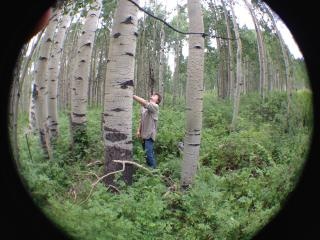Feb 26 2019
Leander Anderegg (Carnegie Institution for Science) and Janneke Hille Ris Lambers (University of Washington) have reported in their new study that climate plays an important role in determining which tree communities will grow under severe conditions on the mountain slopes of the Western United States.
 Lee Anderegg collecting a tree core from a trembling aspen tree (Populus tremuloides) in the La Plata Mountains of Colorado as part of this study. (Image credit: Courtesy of Mike Anderegg)
Lee Anderegg collecting a tree core from a trembling aspen tree (Populus tremuloides) in the La Plata Mountains of Colorado as part of this study. (Image credit: Courtesy of Mike Anderegg)
Their study outcomes, reported in Ecology Letters, play a crucial role in gaining insights into the forest growth shift in response to a climate modified by human activity.
To predict the impact of climate change on forest ecosystems, it is important for scientists to comprehend the factors, including competition for resources and environmental conditions, which affect forest habitats that change over time. According to one of the oldest ecological principles, climate will constrain tree growth under severe conditions and competition between trees will constrain growth under mild conditions.
This question has moved from the realm of academic theory to a critical practical consideration for land managers, who are trying to determine how the ranges of different tree species will shift. So, we wanted to test the theory across a large scale.
Leander Anderegg, Carnegie Institution for Science
Anderegg and Hille Ris Lambers investigated 644 trees over nine elevation ranges on mountain slopes in Montana’s Glacier National Park, Washington’s Olympic National Park, and Colorado’s San Juan National Forest.
They determined that the growth of trees is constrained more by the climate than by resource competition, as anticipated, under severe conditions like dry low elevations or cold high elevations. However, under mild conditions, resource competition was not the only limiting factor as anticipated by the researchers.
Going back to the days of naturalist explorers like Charles Darwin and Alexander von Humboldt, we have been talking about this potential tradeoff between climate-driven growth and competition-driven growth as conditions vary from harsh to mild.
Leander Anderegg, Carnegie Institution for Science
Their findings indicated that this age-old ecological theory was indicative of growth patterns under severe conditions on the regional scale in the western states of the United States. However, forest managers were unable to use this theory to predict forest growth shift in mild environments due to climate change as many other factors other than climate were involved.
Despite this limitation, Anderegg and Hille Ris Lambers hope that further work on this study and taking into account other influencing factors will help ecologists to create modeling tools to anticipate the effect of a modified climate on forest ranges.
This study was supported by the National Science Foundation, a National Oceanographic and Atmospheric Administration Climate and Global Change Postdoctoral Fellowship, a UW Biology Wingfield/Ramenofsky Research Award, and a WRF Hall Research Fellowship.